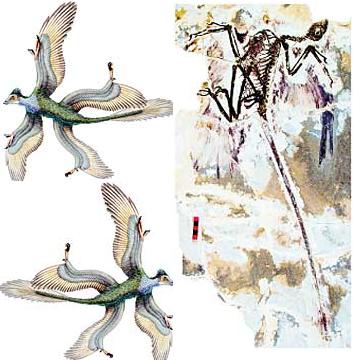Dinosaurs / the feathers on the arms and legs of the "microraptor Goy" allowed him to roam among the trees
Tamara Traubman

Most evolution experts now hold the opinion that the ancestors of birds were dinosaurs. However, the question of how the ability to fly developed still remains unanswered. A fossil about 130 million years old, recently discovered in an ancient lake in the Liaoning region of northeastern China, may provide new information on the issue.
This is a fossil of an unknown four-winged dinosaur. The researchers - Dr. Xing Xu from the Institute of Vertebrate Paleontology and Paleoanthropology in Beijing - gave it the name "Microraptor Gui", after a Chinese paleontologist who did a lot of digging in the area where the dinosaur was discovered.
Shaw and his team discovered six fossil remains of the winged dinosaur about two years ago. Their findings were published for the first time yesterday in the scientific journal "Nature". Scientists today believe that the dromaeosaurs are the closest group of dinosaurs to modern birds.
"The Goi microraptor was a small animal," said Dr. Shaw. "Its entire length reached only about 77 centimeters." The dinosaur's arms and legs were covered in feathers, which the researchers described as "fully developed and modern". Also, his tail is decorated with a tuft of long feathers. According to Shaw, the feathers of the Goi microraptor "are organized in a similar way to that of modern birds".
"It appears that it used its wings and feathered tail to move from tree to tree, quite similar to the way modern flying squirrels move," said Richard Fromm, a professor of paleontology at the University of Kansas, who examined the fossils and wrote a commentary accompanying the publication of the study. Indeed, the research report details several characteristics that support the assumption that the Goy microraptor could have died.
"The way in which the feathers are organized on its hind limbs could have provided it with an excellent 'air surface', which apparently allowed it to fly," Shaw said.
Over the years, the explanations for the development of the ability to fly have focused on two main theories: the "running theory", which holds that the ability to fly developed in animals that lived on the ground and developed strong legs, which allowed them to run and pick up speed in order to rise; and the "tree theory", which holds that the ability to fly appeared in creatures that lived in trees and learned to move between trees. Soaring, claim the holders of this theory, is simpler than the need to accumulate acceleration to take off from the ground.
According to Fromm, "the idea of breastfeeding was first raised in 1915 by William Bibb, in a colorful article that seemed to see the newborn". Bibb proposed that the ability to fly evolved through an intermediate stage of four-winged creatures that roamed among the trees of the primeval forests.
"The Microraptor Goy looks like it could have come straight off the pages of Bibb's notebook," said Fromm. According to him, until now the idea of motherhood was completely hypothetical, but the new fossils revive it. "I think that there is no other way to interpret this, except as new and amazing supporting evidence for the 'tree phase' in the evolution of the ability to fly," he said.
"Although early bird fossils have been discovered from the microraptor goi, flying dinosaurs that resemble it may represent an evolutionary stage between flightless dinosaurs and birds - which lost their hind wings at a later stage," Shaw said.
However, there are scientists who are not sure, because the Goy microraptor does have something to do with the development of the ability to fly. According to Larry Whitmer of Ohio University, even if the microraptor did fly, it may have been a "failed experiment" among one branch of dromaeosaurs, and that current bird flight evolved independently from another ancestor.
